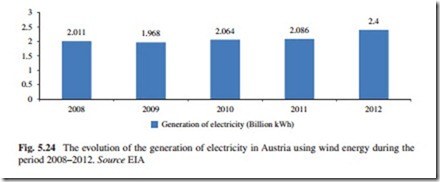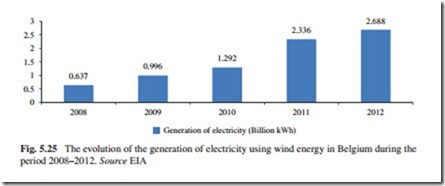Belgium
According to Zervos and Kjaer (2008), with a production of 1.1 % of electricity from renewable energy source in 1997, Belgium was at the bottom of the EU-15 in that year. However, this situation changed in the following years as a result of the adoption of new energy policy. Policy measures in Belgium contain incentives to use the most cost-effective technologies. Biomass is traditionally strong in Belgium, but both hydropower and onshore wind generation have shown strong growth in recent years.
Two sets of measures are the key to the Belgian approach to the use of renew- able energy source for the generation of electricity:
• Obligatory targets have been set (obligation for all electricity suppliers to sup- ply a specific proportion electricity using renewable energy sources), and guar- anteed minimum prices or fallback prices have been foreseen;
• Investment support schemes for the generation of electricity using renewable
energy sources are available. Among them is an investment subsidy for the use of solar PV.
According to EWEA 2011, Belgium has an overall 13 % renewable target for 2020, up from just over 2 % in 2005, the directive’s base year. The NREAP indi- cates that Belgium expects to be slightly above its indicative trajectory through- out, and in end 2020 producing a small excess of 5.4 kiloton oil equivalent. The Belgian authorities forecast that renewable electricity will represent the largest share of renewable in 2020 (20.9 %). With an annual production in 2020 esti- mated at 10.5 TWh, wind energy will cover 9.5 % of all electricity consumption. Belgium’s offshore wind target will be 2 GW by 2020. Nevertheless, net annual wind installations are forecast to grow steadily from just over 200 MW in 2012 to over 480 MW in 2018, 2019, and 2020. It is estimated that by 2020, cumulative capacity will be 4,320 MW, matching EWEA’s 2009 forecast (see Table 5.11).
The wind power capacity installed in the country during the period 2000–2013 increased 127-fold (from 13 MW in 2000 to 1,651 MW in 2013). During that period, the wind capacity installed in the country increased in each one of the years considered. The maximum increase was achieved in 2001.
Wind Farms Offshore in Operation or Under Consideration and Construction According to the Royal Belgian Institute of Natural Sciences, there are five pro- jects for the construction of wind farms in the Belgian part of the North Sea. These projects are the following:
• C-Power on the Thorntonbank;
• Belwind on the Bligh Bank;
• Northwind on the Lodewijkbank;
• Norther southeast of the Thorntonbank;
• Rentel between the Lodewijkbank and the Thorntonbank.
The C-Power wind farm has 60 windmills and is located at 27 km off Zeebrugge. The park will be built in water from 12 to 27 m deep, and the turbines will be installed in an area of 18 km2 in size. Work has started on land in 2007 with the construction of the first 6 foundations. In 2008, the first 6 windmills have been installed at sea.
With a capacity of 330 MW, the Belwind farm will deliver energy to 330,000 households. This wind farm, which is located 42 km off the coast of Zeebrugge, is
today the world’s furthest offshore wind farm. The wind farm will be built in water from 20 to 35 m depth, and the turbines will be installed in an area of 35 km2 in size.
Northwind requested an environmental permit for the construction and exploitation of a wind farm of 144–216 MW. The project would be located on the Lodewijkbank at a distance of 38 km from the coast. The firm in charge of the construction of this wind farm studied the environmental impact study and annexes that were prepared and submitted its own assessment of environmental impact and its advice to the State Secretary for North Sea Affairs on April 15, 2009. Northwind obtained the environmental permit on Nov 19, 2009. They will start the construction in 2011.
The Norther wind farm received the environmental permit for the offshore wind farm to be located Southeast of the Thorntonbank. With a capacity of 258– 420 MW, the Norther wind farm will deliver energy between 230,000 and 430,000 households. The wind farm is located at a distance of 21 km from the coast of Zeebrugge. The wind farm will be built in water from 14 to 30 m deep, and the turbines will be installed in an area of 44 km2 in size. Construction of the wind farm will start in 2014. The wind farm will start delivering electricity by the beginning of 2015.
RENTEL requested on July 2, 2012, an authorization and an environmen- tal permit for the construction and exploitation of a wind farm of between 289 and 550 MW. The project would be located Northwest of the Thorntonbank and Southeast of the Lodewijkbank, at a distance of 31 km from the coast.
Generation of Electricity Using Wind Energy
A study conducted by VITO, the Federal Planning Bureau, and consultancy firm ICEDD, shows that the country could reach the goal to produce electricity using 100 % renewables by 2050. The goal is extremely ambitious, but it is, neverthe- less, possible. The switch to renewable electricity, heat, and transport systems would require a total investment between €300 and €400 billion during the period extending to 2050. If the variable and fixed costs are taken into account, annual expenditures on the energy system will increase by 20 % starting in 2040. This increase from €10 to €15 billion per year would represent approximately 2 % of Belgian GDP (Gross Domestic Product) in 2050. This prognosis, of course, depends on the evolution in fuel prices over the next 40 years.
If the country also succeeds in cutting its demand for energy services and if the government includes in the calculation the costs of global warming that is expected to be avoided, then a number of scenarios appear to generate a net posi- tive effect of up to €10 billion per year starting in 2040. This is a net benefit of approximately 1.5 % of the Belgian GDP in 2050. At the same time, however, it is important to highlight that the transition to renewable energy in the country would generate 20,000–60,000 new jobs and save considerable money that otherwise would go to the import of fossil fuels or to pay for damage due to global warming.
By abandoning fossil fuels, Belgium would make an additional contribution to the fight against global warming. Renewable energy sources are also clean energy, and thus better than fossil energy for air quality. Moreover, the choice of inexhaustible energy sources guarantees the energy supplies today and in the distant future. However, it is important to highlight that converting the Belgian energy system fully to renewable sources would not be an easy task. The coun- try, in fact, has limited renewable energy sources available, the national industry is energy intensive, and the residential sector also uses much energy. This change would require major investments and have significant ramifications for the general infrastructure of the country, because the electricity network, spatial planning, and Belgian buildings would require radical adaptations.
To reach the objective of 100 % renewable energy for the generation of electricity in 2050, the role of renewables should grow substantially, especially during the period 2030–2050, with the electricity sector being the first to make the full transition by 2030. The use of industrial production based on electricity, hydrogen production, heat pumps in buildings, and electric vehicles will need to increase dramatically. Consequently, the country’s present electricity production will need to triple by 2050.
The evolution of the generation of electricity using wind energy in Belgium during the period 2008–2012 is shown in Fig. 5.25.
According to Fig. 5.25, the generation of electricity in Belgium using wind power during the period 2008–2012 increased 4.2-fold. It is expected that the use of this type of energy source for the generation of electricity will continue increasing up to 2050, based on the plans already approved by the government.
Finally, it is important to highlight the following: Government officials have indicated that plans to construct an island for the sole purpose of storing its vast amounts wind energy are under serious consideration. According to different public reports, this is part of Belgium’s plan to wean itself off nuclear energy by 2025, which as of 2011 accounts for more than half of its energy production. The government is confident that the island will solve intermittency issues that commonly occur in renewable energy production, such as wind and solar. The island will use a pumped-hydro system to store excess wind energy generated during off-peak hours, which will then be used to help satisfy the demand during hours when the wind
is not blowing. The 3-km island—shaped like a horseshoe with a vast, deep reservoir located in the center—is to be located 3–4 km off the coast near the province of West Flanders. When the wind is strongest, typically at night, the water will be pumped out of the reservoir through turbines and into the sea. When energy demand is high, the water will be let back into the reservoir through the same turbines.


